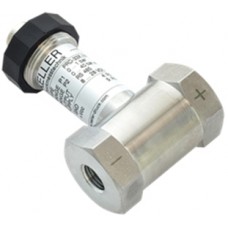Keller Swiss-Built Series PRD-33X Differential Pressure Transmitter for Closed Tank Level Applications
TheSeries PRD-33 Xwas developed for applications that require a high accuracy differential pressure measurement together with high overload resistance in differential pressure ranges as low as 350 mbar.TheSeries PRD-33 Xis the result of ongoing development of the KELLERPD-33 Xdifferential pressure transmitters. Thanks to a second integrated pressure sensor, the line, or common mode, pressure can now be measured along with the differential pressure, resulting in several notable features not found in traditional differential pressure transmitters.Features- High-accuracy differential pressure measurement with compensated line pressure,dependency- Differential pressure range from 350 mbar to 3 bar- Pressure- and temperature-compensated- Signal output: ΔP, base pressure, and temperature- High overload resistance: ± 35 bar also in the 0…350 mbar measuring range- Configurable via RS485 interface incl. software-manager for online data control, data save and programming- Compact structural design including various electrical connections (binder, cable, M12)Applications- Level measurement of technical gases in liquefied gas tanks- Differential pressure measurement in case of high unilateral overload resistanceLevel measurement of pressurized tanksLevel measurement for non-pressurized tanks is a common application, and can easily be accomplished through the use of a “traditional,” relative-type level or pressure transmitter. The reason is that there is no pressure differential between the ullage pressure and barometric pressure. However, pressurized tanks present additional challenges.In closed-system and pressurized tanks, two measurements must be made to calculate media level. Commonly, this is accomplished by using two separate pressure transmitters; one to measure tank pressure (liquid + ullage = P1), and one to measure ullage pressure (P2). Liquid level is then calculated by subtracting the ullage pressure value (P1-P2). Keller differential pressure transmitters make it possible to simplify the process with one instrument, as shown below:
Figure 1In these more traditional applications, a standard differential pressure transmitter would prove adequate, however, other closed tank level applications, such as cryogenic storage tanks, require special transmitter capabilities.Industrial Gas / Cold-converter systems / Cryogenics storage tanksCold storage and cryogenic tanks allow a large amount to be stored economically in a small space. However, the combination of low temperatures and precise level control requirements make standard differential pressure measurement increasingly difficult.
Figure 2For example, during gas withdrawal the temperature and the pressure decrease. If the pressure drops below a defined threshold, liquefied gas is passed into a conduit outside of the insulation, where it is heated and vaporized, which will increase pressure. If too little or no gas is drawn, the inner pressure rises by taking in heat from the outside. If the upper threshold pressure is reached, gas is discharged into the environment which lowers the temperature and internal pressure. The logistics for these tanks is essential, and thus a continuous level monitoring is required.Since the tanks are pressurized, the level measurement is more complex, as not only the liquefied gas column, but also the internal pressure needs to be measured to determine the liquid level. Additionally, varying tank size creates additional difficulties, as smaller tanks (< 3m) have particularly high requirements, since the pressure differential can be as low as 200 mbar (FS) with base pressure as high as 32 bar. When filling and manipulating the valves, the tank pressure may exert onesided on the differential pressure transmitter, while the air pressure is exerted on the other side. That‘s why a onesided overload of 32 bar is required.Keller Differential Pressure Transmitter Comparison Conclusion
Differential pressure measurement provides a streamlined process for efficiently monitoring liquid levels in closed and pressurized tanks. As a world leader in level and pressure measurement instrumentation, Keller differential pressure transmitters are proven to provide outstanding accuracy and versatility to your changing needs.Tags:cryogenic,Differential pressure,Keller AG,Keller America,line pressure,liquid level,low-temperature,PRD-33X,pressure transmitter,tank level,tanks,ullage pressure
Figure 1In these more traditional applications, a standard differential pressure transmitter would prove adequate, however, other closed tank level applications, such as cryogenic storage tanks, require special transmitter capabilities.Industrial Gas / Cold-converter systems / Cryogenics storage tanksCold storage and cryogenic tanks allow a large amount to be stored economically in a small space. However, the combination of low temperatures and precise level control requirements make standard differential pressure measurement increasingly difficult.
Figure 2For example, during gas withdrawal the temperature and the pressure decrease. If the pressure drops below a defined threshold, liquefied gas is passed into a conduit outside of the insulation, where it is heated and vaporized, which will increase pressure. If too little or no gas is drawn, the inner pressure rises by taking in heat from the outside. If the upper threshold pressure is reached, gas is discharged into the environment which lowers the temperature and internal pressure. The logistics for these tanks is essential, and thus a continuous level monitoring is required.Since the tanks are pressurized, the level measurement is more complex, as not only the liquefied gas column, but also the internal pressure needs to be measured to determine the liquid level. Additionally, varying tank size creates additional difficulties, as smaller tanks (< 3m) have particularly high requirements, since the pressure differential can be as low as 200 mbar (FS) with base pressure as high as 32 bar. When filling and manipulating the valves, the tank pressure may exert onesided on the differential pressure transmitter, while the air pressure is exerted on the other side. That‘s why a onesided overload of 32 bar is required.Keller Differential Pressure Transmitter Comparison Conclusion
Differential pressure measurement provides a streamlined process for efficiently monitoring liquid levels in closed and pressurized tanks. As a world leader in level and pressure measurement instrumentation, Keller differential pressure transmitters are proven to provide outstanding accuracy and versatility to your changing needs.Tags:cryogenic,Differential pressure,Keller AG,Keller America,line pressure,liquid level,low-temperature,PRD-33X,pressure transmitter,tank level,tanks,ullage pressure
Write a review
Your Name:Your Review: Note: HTML is not translated!
Rating: Bad Good
Enter the code in the box below:


